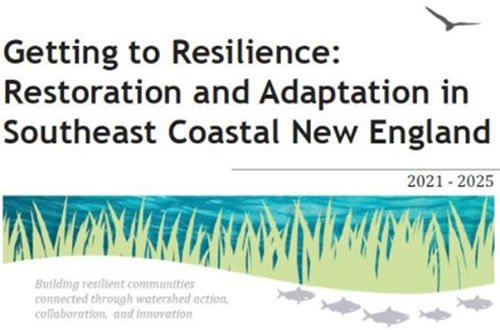Getting to Resilience: SNEP's Strategic Plan for Restoration and Adaptation in Southeast Coastal New England
February 2021

Since its inception in 2012, the Southeast New England Program (SNEP) has provided our communities with over $30 million in funds to better secure the region's natural resources and to better steward and preserve local ecosystems for generations to come. To carry out these ambitious goals, SNEP has crafted a strategic plan entitled "Getting to Resilience: Restoration and Adaptation in Southeast Coastal New England," over the past year that lays out a 30-year vision for our program and incorporates valuable input from our partners, including local community groups, non-profits, local, state, and federal departments and agencies, many of whom serve on our advisory committees.
By 2050, our program envisions a resilient ecosystem of safe and healthy waters, thriving watersheds and natural lands, and sustainable communities throughout SNEP's coastal watersheds. To help make that vision a reality, the plan describes specific outcomes for the future and activities that SNEP and our partners will undertake during each five-year phase.
For Phase I (2021-2025), SNEP aims to:
Increase local capacity to complete projects and adopt new policies
- Increase local capacity by providing financial and technical assistance to communities for the application of environmentally sustainable solutions towards the restoration of water quality and the stewardship of natural habitats
Increase available solutions that address environmental challenges
- Increase available solutions to address stressors/issues by spurring the development, evaluation, and dissemination of innovative technologies, financing approaches, and policy development.
Ensure diverse representation
- Ensure diverse representation of community needs, science, and management solutions in SNEP committees to include a wide range of perspectives and input in program decision-making by building relationships with local communities, municipal/state/federal governments, Tribes, non-profit organizations, businesses, and academia.
Demonstrate ways to address common challenges
- Demonstrate ways to address common challenges by selecting pilot watersheds to support a holistic and targeted watershed management approach that is tailored to the differing characteristics in the region, with a focus on innovative, systemic solutions to environmental stressors that can be transferred to other areas in the SNEP region and beyond.
Increase local buy-in by working with community leaders to demonstrate and quantify the direct and indirect benefits of restoration efforts.
- Increase local buy-in by working with community leaders to demonstrate and quantify the direct and indirect benefits of restoration efforts.
A critical aspect for achieving these goals is our commitment to strong community engagement. This means coordinating at every level to provide a unified approach across SNEP decision-making, SNEP Watershed Implementation Grants, the Buzzards Bay and Narragansett Bay NEPs, the EPA-USGS Collaborative, and the newly minted SNEP Network. It also means expanding our communication and outreach efforts and forming new relationships with community leaders, academic institutions, and members of the business community throughout Rhode Island and Massachusetts. SNEP will continue to solicit community feedback through our partnering organizations within the region to ensure that our program is designed to meet and address the needs of our communities.
The SNEP region is unique in the diversity of its ecology, people and environmental challenges, especially those related to climate change. SNEP's charge is to serve as a regional connector that facilitates discussion and information-sharing; identifying common challenges and sharing common solutions. In the eight years since our founding we have been able to find, fund, test, and implement successful approaches to address a wide range of problems, from developing new ways to reduce nutrient pollution in surface and groundwater, to beginning to understand the impacts of climate change on species migration and refugia throughout the region.
Because the ever-changing nature of these environmental challenges requires flexibility to adapt and adjust based on sound information, our strategic plan outlines the need for a community-driven and informed regional long-term monitoring strategy designed to track environmental change across municipal and watershed boundaries. To monitor progress against the ambitious goals of our program, the plan includes a draft list of key metrics to inform regional indicators on water quality, habitat health, climate change, economic health, recreation and well-being. These metrics and indicators will serve as the foundation of a SNEP monitoring framework that includes both a regional strategy and a protocol for collecting data. They are also meant to be informed by data throughout the region across multiple sources to better inform our regional outlook over time, measure the impact of our implemented projects, and identify areas where further intervention is required.
An ambitious plan requires a sturdy foundation on which to build. Phase one of our strategic plan aims to build such a foundation so that our region will one day realize the vision of safe and healthy waters, thriving watersheds and natural lands, and sustainable communities that we all share. Our strategic plan is a living document designed not with the immediate intent to provide the right answers, but, perhaps even more fundamentally, to ask the right questions. With those in place, the answers will surely follow.
For more information, questions, or comments, please contact [email protected]
